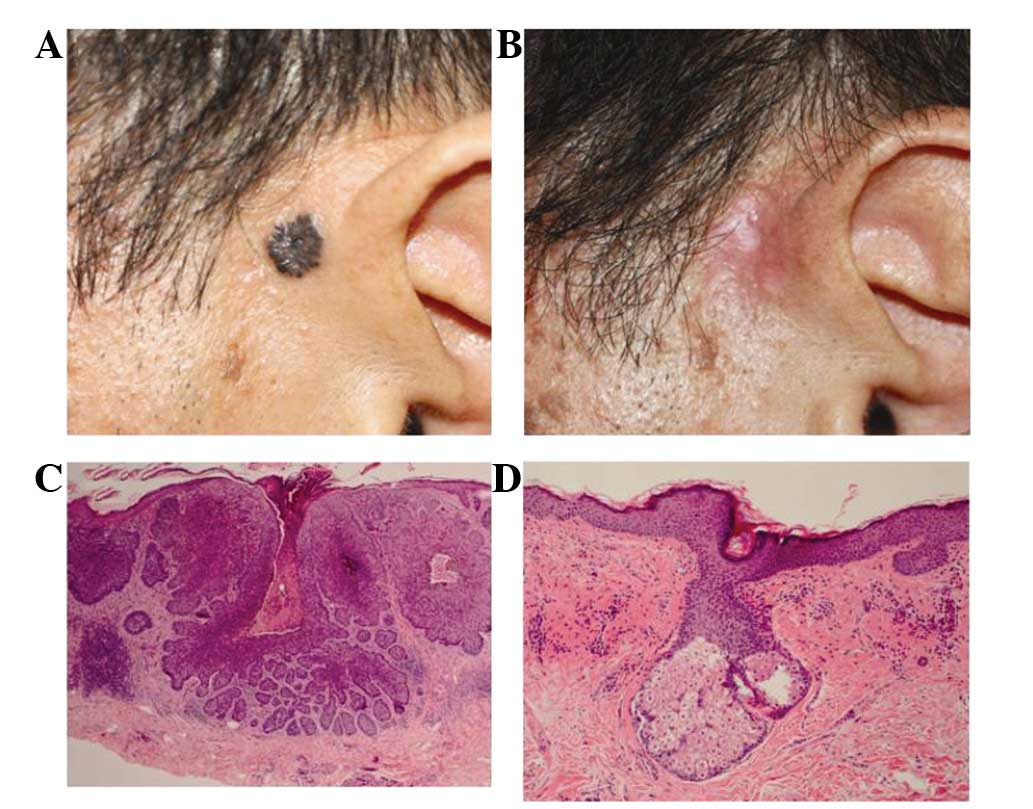Photodynamic therapy combined with cryotherapy for the treatment of nodular basal cell carcinoma
- Authors:
- Sung Ae Kim
- Kyu Suk Lee
- Jae-We Cho
-
View Affiliations
Affiliations: Department of Dermatology, Keimyung University School of Medicine, Dongsan-dong, Jung-gu, Daegu 700-712, Republic of Korea
- Published online on: July 31, 2013 https://doi.org/10.3892/ol.2013.1504
-
Pages:
939-941
Metrics:
Total
Views: 0 (Spandidos Publications: | PMC Statistics:
)
Metrics:
Total PDF Downloads: 0 (Spandidos Publications: | PMC Statistics:
)
This article is mentioned in:
Abstract
Carbon dioxide (CO2) laser ablation in combination with photodynamic therapy (PDT) has previously been successfully used to treat superficial basal cell carcinoma (BCC). However, the efficacy of this treatment modality is limited in the treatment of deeper lesions and the more aggressive subtypes of BCC. In order to improve the outcome of PDT, 8 BCC lesions of variable depths (4 lesions ≤2 mm and 4 lesions >2 mm) and subtypes (1 superficial, 6 nodular and 1 infiltrative) were treated with CO2 laser ablation in combination with PDT, followed by modified cryotherapy. The mean number of treatment sessions was 1.5 and the follow-up period was 22 months. All of the patients demonstrated a complete response and no recurrence of disease, while the majority of patients were satisfied with the cosmetic results upon follow‑up examination. The combination therapy of CO2 laser ablation with PDT followed by modified cryotherapy demonstrated a good efficacy and satisfactory cosmetic outcomes in the treatment of nodular BCC.
View References
|
1
|
Arits AH, Schlangen MH, Nelemans PJ and
Kelleners-Smeets NW: Trends in the incidence of basal cell
carcinoma by histopathological subtype. J Eur Acad Dermatol
Venereol. 25:565–569. 2011. View Article : Google Scholar : PubMed/NCBI
|
|
2
|
Szeimies RM, Ibbotson S, Murrell DF, et
al: A clinical study comparing methyl aminolevulinate photodynamic
therapy and surgery in small superficial basal cell carcinoma (8–20
mm), with a 12-month follow-up. J Eur Acad Dermatol Venereol.
22:1302–1311. 2008.PubMed/NCBI
|
|
3
|
Fantini F, Greco A, Del Giovane C, et al:
Photodynamic therapy for basal cell carcinoma: clinical and
pathological determinants of response. J Eur Acad Dermatol
Venereol. 25:896–901. 2011. View Article : Google Scholar : PubMed/NCBI
|
|
4
|
Miller SJ: Biology of basal cell carcinoma
(Part I). J Am Acad Dermatol. 24:1–13. 1991. View Article : Google Scholar
|
|
5
|
Rhodes LE, de Rie M, Enström Y, et al:
Photodynamic therapy using topical methyl aminolevulinate vs
surgery for nodular basal cell carcinoma: results of a multicenter
randomized prospective trial. Arch Dermatol. 140:17–23. 2004.
View Article : Google Scholar
|
|
6
|
Christensen E, Mørk C and Foss OA:
Pre-treatment deep curettage can significantly reduce tumour
thickness in thick Basal cell carcinoma while maintaining a
favourable cosmetic outcome when used in combination with topical
photodynamic therapy. J Skin Cancer. 2011:2403402011. View Article : Google Scholar
|
|
7
|
Whitaker IS, Shokrollahi K, James W,
Mishra A, Lohana P and Murison MC: Combined CO(2) laser with
photodynamic therapy for the treatment of nodular basal cell
carcinomas. Ann Plast Surg. 59:484–488. 2007. View Article : Google Scholar : PubMed/NCBI
|
|
8
|
Messeguer F, Serra-Guillen C, Echeverria
B, et al: A pilot study of clinical efficacy of imiquimod and
cryotherapy for the treatment of basal cell carcinoma with
incomplete response to imiquimod. J Eur Acad Dermatol Venereol.
26:879–881. 2012. View Article : Google Scholar : PubMed/NCBI
|













